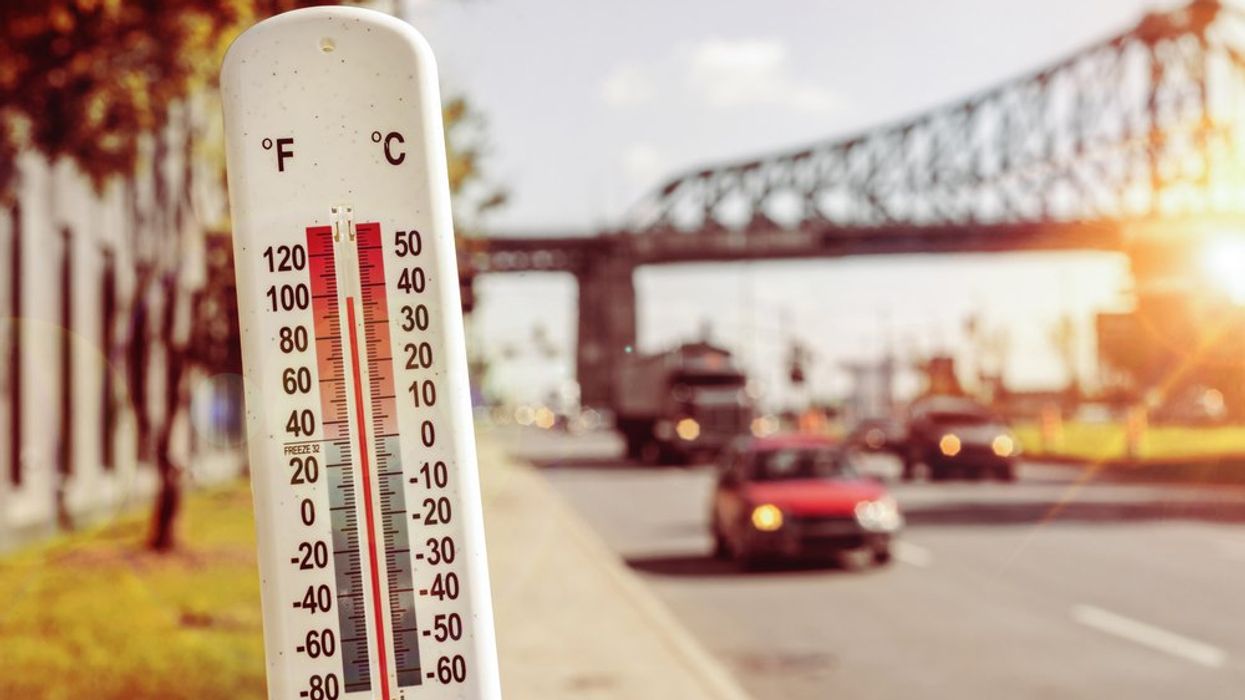Editor's note: Design for Impact is a series spotlighting architectural solutions for communities displaced by the climate crisis, natural disasters and other humanitarian emergencies.
(CNN) — It’s been another hellish summer. A double whammy of the human-caused climate crisis and the arrival of El Niño has fueled soaring temperatures that have made this year downright deadly. July 2023 has been declared the world’s hottest month on record. In a recent address, UN Secretary-General António Guterres ominously described this year as the dawning of “the era of global boiling.”
In Europe, over 60,000 people died last year from heat-related illnesses, with some countries adopting a naming system for heat waves akin to those used for hurricanes and typhoons. The Italian Meteorological Society, for instance, named a recent heatwave “Cerberus,” after the three-headed hound guarding the gates of hell in Dante’s “Inferno.”
Problems are especially acute in densely populated cities where the “urban heat island effect” can result in microclimates about 10 degrees Celsius (18 degrees Fahrenheit) hotter than surrounding areas. The phenomenon, first documented in the 1800s by an amateur meteorologist in London, occurs in areas with high concentrations of heat-absorbing concrete buildings, asphalt surfaces and a dearth of green spaces.
Despite knowing about the perils of global warming for decades, many cities are proving to be woefully unprepared. Now, local officials are appointing “chief heat officers” to expedite “heat action plans,” while start-ups race to invent better air conditioners and personal cooling devices.
Many solutions are based on time-tested design principles. Here are five things cities are doing right now to combat rising temperatures:
Planting trees and green spaces
A healthy canopy of trees is among the most effective and egalitarian defenses against the urban heat island effect. Seeking refuge beneath a tree can feel 11 to 25 degrees Celsius (20 to 45 degrees Fahrenheit) cooler compared to standing in direct sunlight, according to the US Environmental Protection Agency. Apart from the instant relief of shade, a process called “evapotranspiration,” where water transfers from plants and soil into the atmosphere, also helps cool surrounding areas by up to 5 degrees Celsius (9 degrees Fahrenheit).
Barcelona, which has become something of a laboratory for progressive urban interventions, may soon offer a vital case study on the efficacy of trees. Per its “Tree Master Plan,” the Spanish city aims to blanket 30% of its land with a variety of climate-resilient species by 2037. Today, holm oaks, Aleppo pines, plane trees, cypresses and other hardy species already line the city’s streets and new “superilla,” or superblocks, which are essentially reclaimed roads that have been turned into tree-lined public plazas. Only a handful of the planned 503 superblocks were completed in time for this grueling Spanish summer, though the city plans to finish them all by the end of the decade.
Spraying mist
In Chinese cities including Wuhan and Chongqing, where temperatures exceeded 113 degrees Fahrenheit last year, cooling sprays can be found in malls, parks and bus stops. The sprays are sometimes complemented by fleets of “mist cannons” — essentially utility trucks equipped with high-pressure water sprayers (pictured above) — that have been roving big cities in China since 2014, according to the environmental think tank China Dialogue.
Although these cannons were initially introduced to tackle air pollution, a recent study from Seoul National University suggests that spraying fine water particles can lower ambient temperatures by as much as 7%, especially if misters are positioned at optimal angles.
Austria’s capital Vienna has meanwhile designated 22 areas as “cool straßen” (“cool streets”) equipped with drinking fountains, mist showers and smart sprinkler systems that automatically activate when temperatures rise above 35 degrees Celsius (95 degrees Fahrenheit).
Rolling out the awnings
An awning is a simple and inexpensive weather shield that’s fallen out of fashion due to contemporary architecture’s penchant for sleek facades. But as cities become desperate for quick answers to unrelenting heat, canopies may be coming back in style.
The Spanish city of Seville (sometimes known as “the Iberian oven”) has recently expanded its network of large canvas awnings to shield more transit stations, playgrounds, schools and hospitals.
In Tel Aviv, Israel, a series of canopies made with LumiWeave, a “smart” cloth embedded with solar cells, has been installed in the city’s business district. Developed by Israeli product designer Anai Green, the awnings store solar energy during the daytime that is then used to power LED lights woven into the material.
Painting roofs and pavements white
As residents of Greek islands can attest, painting rooftops and buildings white is an easy and relatively inexpensive defense against hot summers. Benefiting from something called the “albedo effect,” a structure with a clean white roof reflects around 85% of direct sunlight compared to a dark roof, which reflects only about 20%.
Now, a research team at Indiana’s Purdue University claims to have developed a type of “ultra-white” paint that can reflect 98% of sunlight and lower a building’s surface temperature compared to its surroundings by nearly 20 degrees Fahrenheit at night (or by 8 degrees Fahrenheit during strong sunlight).
Covering a roof area of around 1,000 square feet in this paint would produce the equivalent of 10 kilowatts of “cooling power,” said Xiulin Ruan, a professor of mechanical engineering at Purdue, in a press statement. “That’s more powerful than the central air conditioners used by most houses.”
In Los Angeles, the city’s Bureau of Street Services has in recent years been painting roads in a reflective white-gray coating called CoolSeal. In 2019, after a 10- to 15- degree Fahrenheit cooling effect was recorded in pilot areas, LA’s then-mayor Eric Garcetti announced a plan to cover 250 miles of road lanes with cooling material by 2028 — an initiative that will cost the city an estimated $40,000 per mile, according to journal published by the Royal Institute of British Architects.
But white isn’t the only cooling pigment. A pilot project in LA’s Pacoima neighborhood is testing the efficacy of street coatings that come in a variety of colors. According to the manufacturer, StreetBond, the acrylic-based colorant is designed to reduce urban heat island effect by at least 10 degrees Fahrenheit.
But as cities invest in solar reflective coatings, a 2020 study published in the journal Environmental Research Letters threw cold water on the strategy by suggesting that while reflective sidewalks do result in cooler surface temperatures, humans in these spaces may actually feel warmer because they end up absorbing the heat. “Solar reflective coatings are not a policy panacea for urban heat problems,” the authors wrote, adding that municipalities “need to consider when and how people use land to decide which heat metric (air, surface, or radiant temperature) should be prioritized.”
Returning to local materials and traditional building techniques
A growing cadre of architects and urbanists are eschewing Western architectural traditions by embracing the natural ventilation, traditional construction techniques and materials like insulating mud bricks that have been used for millennia by those living in hot climates.
Pritzker Prize-winning architect Francis Kéré, for instance, creates a sense of airiness through his inventive use of clay, laterite stones, eucalyptus branches and dead wood. School buildings Kéré designed in his native Burkina Faso show how to build comfortable and convivial spaces in extremely hot weather — without the need for AC.
In the southern Indian state of Tamil Nadu, the Auroville Earth Institute has become a locus of this burgeoning “vernacular” architecture movement. Over nearly four decades, the research center has been collaborating with architects and builders around the world interested learning how to build economical and low-carbon structures from compressed mud and soil. Compared to concrete, glass and steel, traditional earth bricks absorb more heat and humidity.
Indian architect Anupama Kundoo, who has built several structures in Auroville, is known for beautiful, climate-resilient buildings made “with materials sourced on the spot,” as she has described her work. Speaking at last year’s The World Around Summit in the Netherlands, Kundoo made a compelling case for recognizing the unique qualities of a area’s geography — and building with whatever is abundant there.
“If you look at pre-industrial architecture, we built with any material,” she explained. “If there was mud, we used mud; if there was wood, we used wood; if it’s a desert and there’s no wood, you build domes; if there’s ice, you use ice.”
“There is a deep, deep relationship between what you produce and where you use it,” she added.
The-CNN-Wire
™ & © 2023 Cable News Network, Inc., a Warner Bros. Discovery Company. All rights reserved.


















































